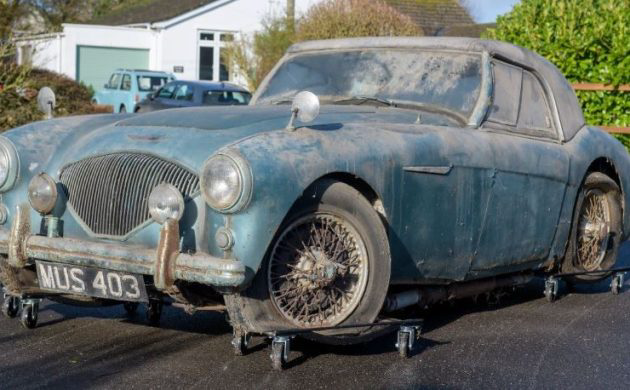
Donald Healey’s automotive career began on the rally course, specifically at Monte Carlo, in 1929. Later, his employment at Riley and Triumph gave him responsibility for the production of new models. A less illustrious period ensued with Triumph Motors’ liquidation in 1939 and the onset of WWII; Healey stitched together a variety of war-time work to keep the fires burning. The real show began in 1945 when Healey – who had been aching to build his own car – founded the Donald Healey Motor Company. His first production attempt was the Elliott, an expensive saloon that promptly established a solid rally record. Maintaining the theme of high-dollar/low production, the firm launched several more models, including the Nash-Healey. a polyglot of a car involving Nash Motors, Pininfarina, and Healey. But the auto industry was blossoming, and Healey shifted his approach to appeal more broadly, aiming for a stylish, less expensive, well-performing sports car. That car was the Austin-Healey 100, launched with vigor – an early example was raced at Bonneville and broke multiple speed records – in partnership with Austin in 1953. Fast and beautiful, the new Healey formed the basis for many brilliant, later iterations. A fondness for the earliest of the Healey line-up keeps the market for the 100 lively, and a keen interest will be required to move this 1954 Austin-Healey 100 BN1 along to a new garage. It will be auctioned by Dore & Rees in Somerset, United Kingdom on April 13. The estimate is £14,000 – £17,000. As we’ll see, this example has been long neglected.

Long-term ownership is generally an attractive feature, but alas, storage since 1974 has not benefitted either the condition or value of this early Austin-Healey. The car’s shut lines have all but disappeared. No photos of the underside are included in the listing, perhaps for fear of breaking her in half on the lift. Meanwhile, the Austin 90-derived 2.6-liter four-cylinder engine is rusted topside, and I’ll hazard a guess it does not turn. Just as the engine came from a doddering saloon, so did the gearbox, but it had to be altered from column shift to floor shift; furthermore, it was no match for the differential and the engine, making first gear virtually useless. That gear was blanked off, leaving the ‘box with only three speeds. Groans from marketing prompted the addition of overdrive to resurrect the sporting nature of the whole thing.

The interior is this car’s strong suit – if there is one. Still, the dark blue leather and virtually every other surface will need renovation. The good news is that with a car never restored, it’s easy to reference the correct colors, materials, fit, and equipment.

Purists may swoon over the still-intact trunk insulation. But there’s no escaping the shabby condition of this Healey. I’ve often joked that British enthusiasts are willing to restore a car so long as they have the glove-box lid, and this prospect is not much farther along than that. It is much too far gone to consider it for a “survivor” class. In the US, we might view it as nothing better than a parts donor. Values hover around high four digits to low (very low) five digits for project 100s. I’ll be shocked if it sells for more.






Was this in the barn or buried underneath it?
Take the barn and leave the car?
Take 2,,,to staff, still something wrong. I get “logged out” mid comment. However, I’ve realized, there’s more important things to complain about, like $7 boxes of popsicles.
Anyway, speaking to the staff, Jesse, you wanted a “100”, well, here you go. I read, $17,000 pounds( I think that symbol means) is about $21,000 dollars, PLUS shipping, OY, in a container? That could put you underwater, and no reference to the Key bridge disaster, an isolated incident, btw and thousands of containers make their destination.
I can’t imagine how many are left here, you know, auction time agin, this time from Houston, and not ONE Big Healey came through. That tells me, the people that have these great cars, aren’t selling them. And project Big Healeys, IDK, maybe check the local Copart,,,sorry that still grinds my gears,,and another thing, how does a car from England rust this badly?
Howard, I’m pretty sure that the Brits INVENTED rust in order to ensure that cars would need replacing in double quick time, thus keeping the motor industry in full swing! You might know that it rains just about incessantly here in UK and to the authorities SALT is their only answer! Water+Salt=Rust. I had a new 1955 100/4 in Rhodesia and 50 years later my friend bought it from a classic car dealer and it had NO rust. I had a 1960 3000 BN 7 in South Africa in about 2000 and sold it to a restorer and he found very little rust in it. When I bought the 100/4 in 1955 it cost £10050. I sold it for £800 a few months later as the girl friend didn’t like getting her starched petticoats wet every time the soft top leaked. The 3000 I paid about $3500 for and sold for $4000 a few months later to the restorer. fellow. When I became a classic car dealer in 2002 he brought it in to me to sell on consignment and it sold for $7000 and 7 years later the buyer brought it to me to resell and it went for $17,000!
Was it stored in the bottom of a pond?
A Prince, in Frog’s clothing?
A two-owner car I think; the second being rust. Which appears to have a firm grip that may not be relinquished.